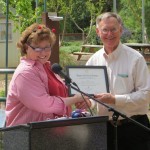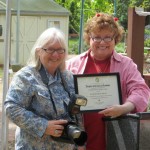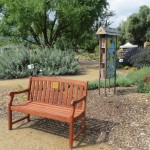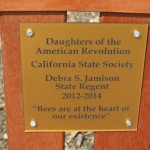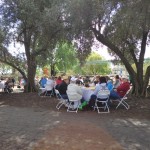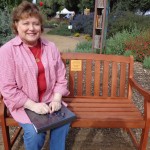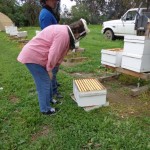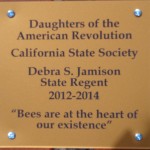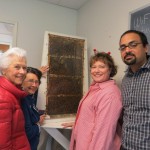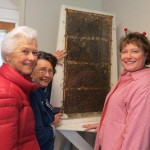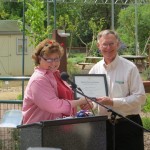Friday, March 28 at University of California – Davis, was a beautiful day to picnic with the bees under the olive trees on Bee Biology Road. If you were one of the over one hundred-twenty DAR members and guests there for the presentation, you too must have been filled with the excitement of seeing Phase II of the State Regent’s Project come to life!After remarks by State Regent Debra Jamison and Ed Lewis, Professor and Vice Chair of the UC Davis Department of Entomology and Nematology, a check for $15,000 was presented to Christine Casey, Manager of the HäHagen-Dazs Honey Bee Haven. She shared that some of the funds have been used to purchase two benches and use of remaining funds will include a shade structure and additional bee habitat. The lovely luncheon celebration was generously organized by the UC Davis College of Agricultural and Environmental Sciences and catered by the university. After lunch, visiting at the tables, and tour of the Haven, we gathered in the Harry H. Laidlaw facility conference room for bee presentations by Assistant Professor/Bee Researcher Brian Johnson and Eric Mussen, Extension Apiculturist. Last year, a $30,000 check was presented from California DAR to UC Davis for bee research. Dr. Johnson reported on the status of that financial support, which covers a two-year period of graduate student research. Gerald Smith researches the effect of pesticide exposure in the field on honey bee foraging behavior and Cameron Jasper studies the genetic basis of division of labor in honey bees. Dr. Johnson stated that this generous donation would provide research funds for many years in the future. Dr. Mussen talked about the life cycle of bees and the issues they face: diseases, malnutrition, parasites, pesticides, pests, and stress. He warned that just because certain pesticides are labeled for use in organic gardening, it does not mean that they are less dangerous for non-target insects, particularly pollinators. Insecticides are watered into the soil, move from the roots throughout the plants, and are secreted in the nectar and pollens when the plants bloom. The attendees were encouraged to plant for bees, providing food for their nutritional needs especially in the late summer and fall. Good plant lists are found on the UC Davis Entomology and Nematology’s bee biology website www.beebiology.ucdavis.eduor on the Xerces website www.xerces.org under “Pollinator Conservation Resource Center.” Thank you for your generous donations and continuing interest in the State Regent’s honey bee projects! Due to your support during the Jamison Administration, you have made a lasting contribution to a vital part of our environment. Karen Montgomery, State Chair State Regent’s Project Kjm1776@att.net

